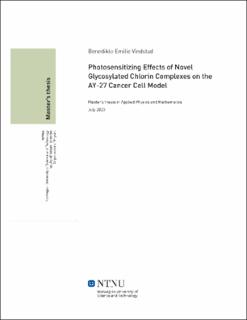| dc.contributor.advisor | Lindgren, Mikael | |
| dc.contributor.advisor | Gederaas, Odrun Arna | |
| dc.contributor.author | Vindstad, Benedikte Emilie | |
| dc.date.accessioned | 2021-09-28T18:38:28Z | |
| dc.date.available | 2021-09-28T18:38:28Z | |
| dc.date.issued | 2020 | |
| dc.identifier | no.ntnu:inspera:60760061:30837947 | |
| dc.identifier.uri | https://hdl.handle.net/11250/2785556 | |
| dc.description.abstract | Målet for dette prosjektet var å finne potensialet til KA20-familien av glykosylerte kloriner som fotosensibiliserende forbindelser i fotodynamisk terapi (PDT) av kreftsykdom. Kreft er en av verdens ledende dødsårsaker. Siden konvensjonelle behandlingsmetoder som cellegift og strålesbehandling medfører store bivirkninger, er det av interesse å utforske nye behandlingsmetoder. En slik ny metode er PDT, hvor et fotosensibiliserende stoff aktiveres av synlig lys for å drepe kreftceller. KA20-familien er potensielle nye fotosensibiliserende stoffer som kan forbedre effekten av PDT.
For a bestemme virkningen av KA20-klorinene i PDT ble rotteceller fra blærekreftcellelinjen AY27 inkubert med forbindelsene. Påfølgende belysning med blått lys forårsaket en nedgang i cellenes viabilitet på opp til 80 % etter 60 sekunder og 95+ % etter 120 sekunder, sammenlignet med ubehandlede celler. Fluorescensmikroskopi bekreftet opptak av stoffene i cellene, og optiske målinger bekreftet singlet-oksygenproduksjon. Fra disse resultatene ble det fastslått at de glykosylerte klorinene var i stand til å effektivt gjøre skade på kreftceller, og at de har potensiale som fotosensibiliserende stoffer innenfor PDT. | |
| dc.description.abstract | The aim of this project was to determine the potential of the KA20 family of glycosylated chlorins as photosensitizers in photodynamic therapy (PDT) of cancer. Cancer is one of the most common causes of death in the world. Because conventional treatments such as chemotherapy and radiotherapy have substantial side effects, it is of interest to explore new treatment modalities. Photodynamic therapy, where a photosensitizer is activated by visible light to kill cancer cells, is one such new treatment. The KA20 family are new potential photosensitizers which may improve the effectiveness of PDT.
To determine the potency of the KA20 chlorins in PDT, rat bladder cancer cell line AY27 were incubated with the compounds. Subsequent illumination with blue light caused a reduction in cell viability of up to 80 % 60 seconds and 95+ % after 120 seconds, relative to untreated cells. Fluorescence imaging confirmed uptake in the cells, and optical measurements confirmed singlet oxygen production. From these results, it was found that the glycosylated KA20 chlorins were effective at causing injury to cancer cells, and that their potential as photosensitizers in photodynamic therapy is present. | |
| dc.language | | |
| dc.publisher | NTNU | |
| dc.title | Photosensitizing Effects of Novel Glycosylated Chlorin Complexes on the AY-27 Cancer Cell Model | |
| dc.type | Master thesis | |
